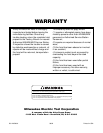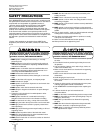
11. Do not operate unless hook travel limit devices function.
Test without load each shift.
12. Do not operate when hoist is not centered over load.
13. Do not operate if chain is not seated properly in sprockets
or sheave grooves.
14. Do not operate damaged or malfunctioning hoist.
OVERLOAD LIMITING PROTECTION
This hoist is equipped with a factory-calibrated overload
limiting clutch that will permit the lifting of loads within its rated
capacity, but will prevent the lifting of damaging overloads while
the hoist is being operated. If the load being lifted exceeds the
lifting capability of the overload clutch, the hoist motor will
continue to run, causing overheating of both the clutch and
hoist motor.This condition should be avoided by immediately
releasing the “UP” button and reducing the load to within the
rated capacity of the hoist. See GEARING, page 10, for
additional instructions on this device.
MAINTENANCE
INSPECTIONS
A planned inspection routine should be established for this
hoist based upon frequency of use, severity of use, and
environmental conditions, (Reference ASME Standard
B30.16). Some inspections should be made frequently (daily to
monthly) and others periodically (monthly to yearly). It is
strongly recommended that an Inspection and Maintenance
Check List and an Inspector’s Report, similar to those shown in
Figures 10A and 10B, be used and filed for reference. All
inspections should be performed or overseen by a designated
inspector.Special inspections should be made following any
significant repairs or any operating occurrence leading one to
suspect that the hoist’s capability may have been impaired.
LOWERING WITHOUT POWER
If the power fails with a load suspended, the hoist will
automatically stop. In an emergency the load can be lowered
without power as follows:
1. DISCONNECT HOIST FROM POWER SUPPLY AND
REMOVE ELECTRICAL COVER.
2. Open disc brake manually by using two screwdriver blades,
one on each side of the brake at a point close to the brake
spring posts. Apply pressure to the underside of the
armature plate (points “X”, Figure 6, page 9) to close the
solenoid and release the brake.
3. Use several quick releases instead of holding brake open
continuously. Do not exceed normal lowering speed.
HOOKS
Refer to Figure 2.
1. Inspect hooks once daily for cracking, extreme wear or
spreading. Replace hooks showing any of these signs.If the
throat openings are spread wider than the maximum
permissible 15% increase listed here, the hooks have been
overstressed and must be replaced.Any hook that is bent or
twisted more than 10° from the plane of an unbent hook
must also be replaced.
2. The hook latches should be inspected to ensure that they
close the hook throat opening in a secure manner when a
load is applied. Inspect the hook shank and nut for any
stripping of the threads or other damage.The hook nut should
be fully restrained by the retaining pin.
3. In addition to above, load hooks should be inspected for
cracks by the magnetic particle, dye penetrant or other
suitable crack testing inspection method.This should be
done at least once a year.
1 Ton & Under 1
11
/
32
"1
7
/
32
"
2 Ton 1
11
/
32
"1
11
/
32
"
(*) Maximum permissible throat opening of hook.
6
Milwaukee Electric Tool Corporation
13135 West Lisbon Road
Brookfield, Wisconsin 53005
TEL: (800) 729-3878
Do not allow screw driver blades to touch rotating
friction disc “C”.
Do not allow the load to descend rapidly. This causes
the motor to race and serious damage may result.
“X”Dimension*
Hoist Top Bottom
Capacity Hook Hook
The overload limiting clutch is an emergency
protective device and should not be used to measure
the maximum load to be lifted, or to sense the
overload imposed by a constrained load. While the
overload limiting clutch will protect the hoist from
damaging overloads, it will not ensure that a load is
within the rated capacity of the hoist.
Do not use hoist to lift, support or otherwise
transport people.
Figure 2 — Hook
Inspection


















